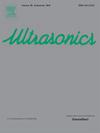Excitation of single mode shear horizontal (0,1) guided wave in a narrow plate waveguide using d24 piezoelectric wafers
IF 3.8
2区 物理与天体物理
Q1 ACOUSTICS
引用次数: 0
Abstract
Piezoelectric ultrasonic transducers are widely used for exciting shear-horizontal (SH) guided waves in narrow plate waveguides (NPW) for high-temperature wall thickness monitoring. The SH(0,1) mode in NPW exhibits nearly nondispersive propagation, making it ideal for monitoring. However, achieving high modal purity and ensuring optimal size matching between the transducer and NPW remain challenging. Existing studies approximate NPW behavior using dispersion curves of plates with infinite width (PIW), leading to inaccuracies in transducer excitation parameter selection. To address this issue, this study develops a dispersion-based excitation parameter selection method for single-mode SH(0,1) wave generation using face-shear (d24) PZT wafers. First, dispersion analysis of SH waves in NPW is conducted using the Floquet periodic boundary conditions method, comparing NPW and PIW dispersion curves to evaluate their differences. Results indicate that in NPW, the cutoff frequency of the SH wave decreases with increasing plate width but remains independent of plate thickness—this contrasts with PIW, where the cutoff frequency varies with plate thickness. Next, based on the dispersion characteristics of SH waves in NPW and SH(0,1) mode shapes, a transducer design optimization approach is proposed. The optimal width and excitation frequency of a symmetrically double-sided d24 PZT wafer transducer are determined. Finite Element simulations and experimental validation are employed to assess the impact of wafer length on excitation performance. Results show that wafers of 6–36 mm length can excite the SH(0,1) mode in a 30 mm wide NPW, with excitation purity and signal-to-noise ratio maximized when the wafer length matches the SH(0,1) mode shape (18–24 mm). A transducer-to-NPW size ratio of 0.6–0.8 enables nearly nondispersive, single-mode SH(0,1) wave excitation. This study provides theoretical guidance for transducer design and has potential implications for broad engineering applications.
利用d24压电片激发窄板波导中单模剪切水平(0,1)导波
压电式超声换能器广泛应用于窄板波导中激发剪切水平导波,用于高温壁厚监测。NPW中的SH(0,1)模式表现出几乎非色散传播,使其成为理想的监测模式。然而,实现高模态纯度并确保换能器和NPW之间的最佳尺寸匹配仍然具有挑战性。现有的研究使用无限宽板的色散曲线来近似NPW行为,导致换能器激励参数选择不准确。为了解决这一问题,本研究开发了一种基于色散的激励参数选择方法,用于使用面剪切(d24) PZT晶圆产生单模SH(0,1)波。首先,利用Floquet周期边界条件法对NPW中的SH波进行色散分析,比较NPW和PIW的色散曲线,评价两者的差异。结果表明,在NPW中,SH波的截止频率随板宽的增加而减小,但与板厚无关,而在PIW中,截止频率随板厚的增加而变化。其次,根据SH波在NPW和SH(0,1)振型下的色散特性,提出了一种换能器优化设计方法。确定了对称双面d24 PZT晶圆换能器的最佳宽度和激励频率。采用有限元模拟和实验验证的方法评估了晶圆长度对激励性能的影响。结果表明,在30 mm宽的NPW中,长度为6 ~ 36 mm的晶圆可以激发SH(0,1)模式,当晶圆长度与SH(0,1)模式形状(18 ~ 24 mm)匹配时,激发纯度和信噪比最大。换能器与npw的尺寸比为0.6-0.8,可以实现几乎非色散的单模SH(0,1)波激发。该研究为换能器的设计提供了理论指导,并具有广泛的工程应用前景。
本文章由计算机程序翻译,如有差异,请以英文原文为准。
求助全文
约1分钟内获得全文
求助全文
来源期刊

Ultrasonics
医学-核医学
CiteScore
7.60
自引率
19.00%
发文量
186
审稿时长
3.9 months
期刊介绍:
Ultrasonics is the only internationally established journal which covers the entire field of ultrasound research and technology and all its many applications. Ultrasonics contains a variety of sections to keep readers fully informed and up-to-date on the whole spectrum of research and development throughout the world. Ultrasonics publishes papers of exceptional quality and of relevance to both academia and industry. Manuscripts in which ultrasonics is a central issue and not simply an incidental tool or minor issue, are welcomed.
As well as top quality original research papers and review articles by world renowned experts, Ultrasonics also regularly features short communications, a calendar of forthcoming events and special issues dedicated to topical subjects.
 求助内容:
求助内容: 应助结果提醒方式:
应助结果提醒方式:


